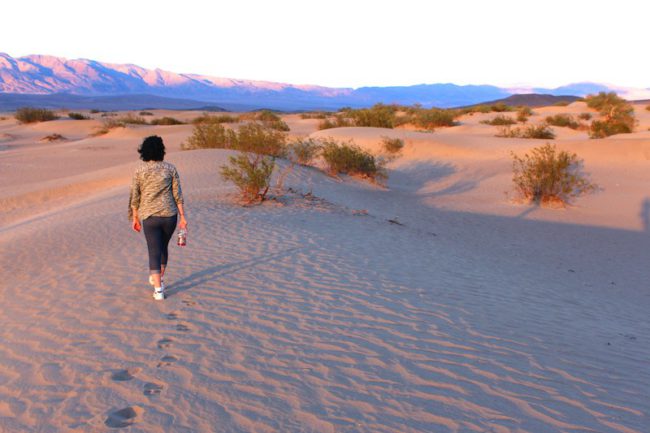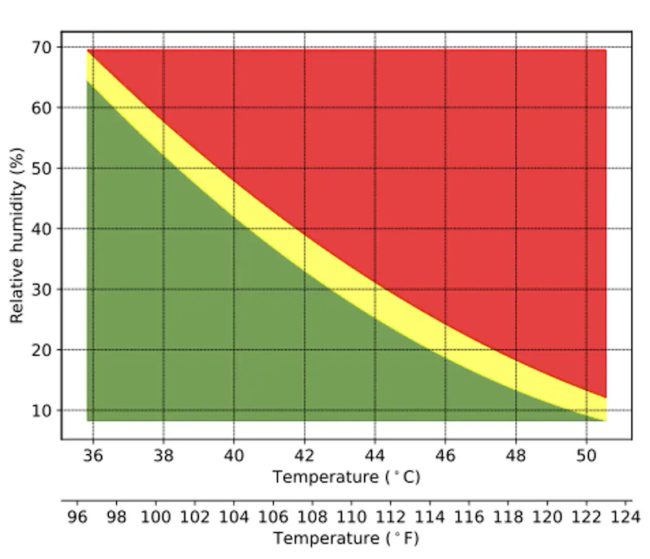
Back in June last year, I was answering this question, “How Hot is too Hot for you to survive?“. The answer then was that the upper limit for human survivability was 35 C.
That sounds weirdly low. Stick with me, we will come to that shortly.
Where I’m going with this is that there has been new research that reveals a new, lower limit.
OK, back to that limit. Even 35 C being an upper limit sounds totally crazy. Many humans (including me) live in places on the globe that see temperatures rise above 35 C, yet we thrive and survive, so how can this possibly be the upper limit?
Let’s take this step by step.
Wet Bulb Temperatures
That limit is actually a wet bulb temperature.
In other words, this is not the normal air temperature of 35C. The secret sauce here is that this is a measurement that also considers humidity.
There is a cooling effect from evaporation.
A key to understanding this is to remember that a high temperature, of say 46C, is something humans can easily survive if the air is dry, but bump up the humanity, by let’s say 50%, and it becomes a very different story. That would yield a wet-bulb temperature of about 35C. Prolonged exposure to that will result in most strong normal healthy humans dying from hyperthermia. Basically you overheat, your core temperature rises too high, and so that is your very own personal end-of-days opportunity.
How do you measure a Wet-Bulb Temperature?
If you wrap a thermometer with a water soaked cloth and then let the atmospheric air pass over it, you are getting a cooling effect via the evaporation of the water.
Back to my example; the hot air might be 46C, but the evaporation from the wet cloth will cool the temperature and so the actual reading will not be 46C, but rather a lot less.
How much less?
That will depend upon the humidity of the air. The more humid it is, the less evaporation can cool things. If for example the air at 35C was at 100% humidity, then evaporation can’t take place because the air can’t absorb any more moisture. Net effect, the wet-bulb temperature would in that case be the same as the atmospheric temperature … 35C.
In drier hot air you don’t just feel cooler, you actually are cooler.
Evaporation enabled by drier air enables you to stay a lot cooler. If right now you were in Death Valley and the forecast was expected to be 110°F to 120°F+ (43°C to 49°C+) then you would be OK. This is because it is also very very dry, so your sweat keeps you cool and brings the temperature down. Well yes, the air conditioning inside the aptly named Furnace Creek visitor center is also more than a tad helpful if you happen to be crazy enough to visit in the summer (as I was).
Why is a 35C wet-bulb temperature fatal?
Yes I know, the new limit is lower than 35C, we will come to that shortly. Let’s just stick with that previous limit for a moment.
Why was it 35C?
Your core body temperature is 37 C and so your skin maintains a temperature of 35 C (or below) so that the core temperature can be maintained. If the wet-bulb temperature rises above 35C then no matter how much you sweat, it will not cool you below that critical 35C. Unless you gain access to air conditioning then you will overheat. The word used to describe that is Hyperthermia — the opposite of hypothermia (too cold). It is perhaps more common to call it heat stroke.
Early symptoms include confusion, delirium, dizziness, weakness, agitation, combativeness, slurred speech, nausea, and vomiting. Lack of access to cooling leads to vital organ damage, unconsciousness, organ failure, and death. Even if you do recover, it can also lead to long-term disability.
Today the wet-bulb temperature generally never exceeds 30 or 31C anywhere, but in a warming world we are fast approaching a time when we will hit and then pass that 35C limit.
Not even the fittest of humans can survive this limit without air conditioning. Even in well-ventilated shaded conditions, when the wet-bulb temperature stays above 35C you will overheat.
But wait, it’s not actually 35C we need to now worry about, so let’s get into that now.
What is the latest Update?
The published paper is titled “Evaluating the 35°C wet-bulb temperature adaptability threshold for young, healthy subjects (PSU HEAT Project)“.
The essence of it is this …
- Up until now the 35C wet bulb limit has been theoretical. While based upon solid physiological principles, nobody had actually tested it on people.
- This study changes that by testing young healthy adults.
- They got those that took part to swallow a small telemetry pill. (wow, now that’s cool). This monitored their deep body or core temperature. They were then placed into a controlled environment and asked to simulate normal passive activities (eating, cooking, etc…). In a controlled fashion they then increased temperature and humidity and measured the core body of the participants.
- When those core body temperatures started to rise then they knew they had reached the actual limit.
Keep going, which is of course something they did not do for rather obvious ethical reasons, and heat related illness would take hold.
So what was the new measured limit?
They got this answer …
Our studies on young healthy men and women show that this upper environmental limit is even lower than the theorized 35 C. It’s more like a wet-bulb temperature of 31 C (88 F). That would equal 31 C at 100% humidity or 38 C (100 F) at 60% humidity.
They also have a handy chart that shows you where the line is …

Bottom Line
I really don’t need to say this, but hey, here it is.
In a warming world where temperatures are rising towards this limit in many places, this is going to become a very very serious challenge.
Further Reading
- The New paper – “Evaluating the 35°C wet-bulb temperature adaptability threshold for young, healthy subjects (PSU HEAT Project)“
- Article Published by the papers authors within The Conversation on July 6th, 2022 – How hot is too hot for the human body? Our lab found heat + humidity gets dangerous faster than many people realize